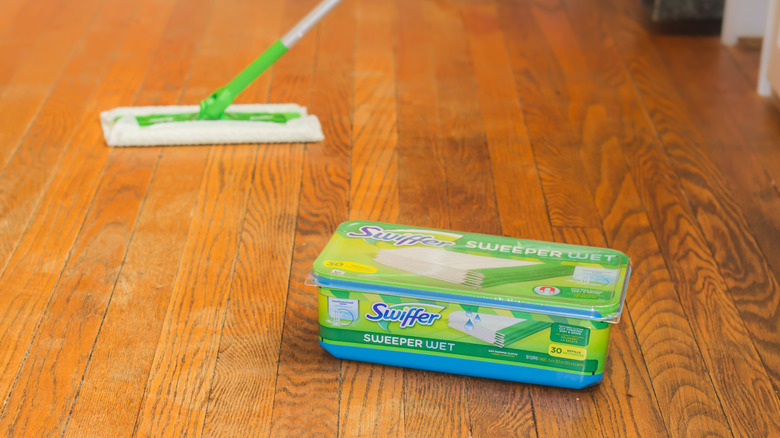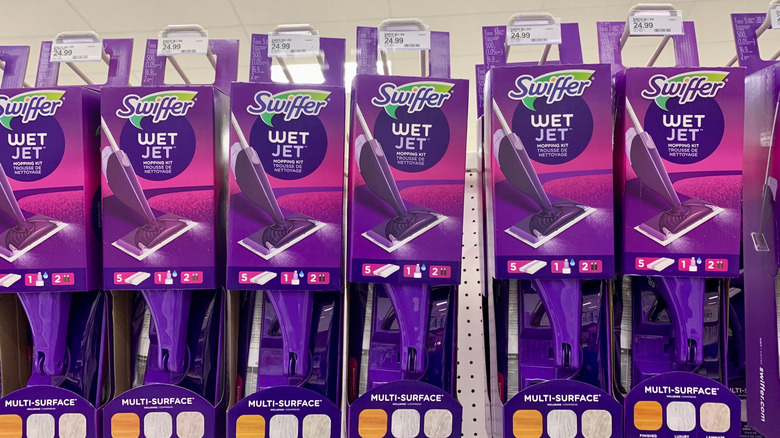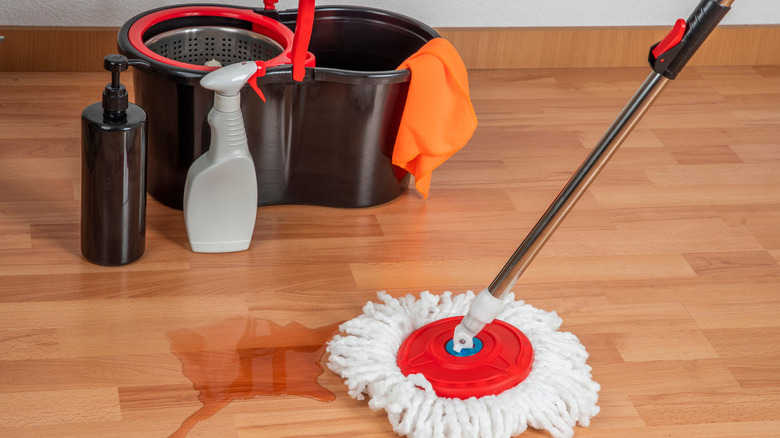Why You May Want To Think Twice Before Grabbing A Swiffer To Clean Your Home
We may receive a commission on purchases made from links.
A Swiffer is the household cleaning equivalent of the single-use coffee pod. It's convenient, but costly to your pocketbook, the environment, and potentially your health. It's also not as effective at cleaning as you might think. The virtue of the Swiffer is not only its ease of use, but the disposable nature of its mopping cloths. It's wise to regularly replace your cleaning tools, and the Swiffer makes that easy. But that's also the problem. Swiffers produce a lot of plastic waste at home and their cleaning solutions may be hazardous to your health — not to mention the fact that your nearest big box store doesn't give out replacement mopping cloths for free.
The initial cost of a Swiffer starter kit (mop with single-use wet and dry mopping cloths) can be under $25. Together, a replacement pack of 52 dry cloths and 24 wet cloths can cost roughly the same as the original Swiffer kit, so if you're using your Swiffer once a week and throwing out your mopping cloths every time, you're more than doubling your cost in just one year. A simple mop like the KeFanta self-cleaning twist mop, which may last the same amount of time, can cost half the price with a lot less waste. There are cheaper, safer, greener, and more effective alternatives to the Swiffer.
The downsides of using Swiffer compared to alternatives
Unlike a mop, Swiffer is not as versatile in terms of the surfaces you can clean or the cleaning solutions you can use. It's great to use a Swiffer wet mop on laminate floors, but the mopping cloths aren't suited for unfinished, waxed, or oiled wooden floors, marble floors, and unsealed tiles. The dry mop is very effective at picking up smaller particles like dust, but for bigger particles like dirt or crumbs, you'll want to get out the vacuum first. And the dirtier your floor, the more likely it is that your Swiffer cloth will lose its electrostatic effectiveness at cleaning, forcing you to pause and replace the cloth. So much for saving time.
If you've lived a Swiffer-free life up to this point, you can find alternatives that perform just as well or maybe even better. There are microfiber spray mops with dual-sided mop heads that you can throw in the washing machine when they're dirty. Electric spinning mops like the ones the janitor used after you left your school a total mess now come in sizes fit for home use. And steam mops use high-temperature steam rather than chemicals to clean and kill germs. None of these alternatives require you to use Swiffer's cleaning solutions.
Repurposing your Swiffer to avoid environmental and health impacts
If you dislike the strong smells of the cleaning solutions in the Swiffer's wet mopping cloth, perhaps your nose is telling you something. Some of the chemicals in Swiffer's cleaning solutions have received failing grades from the Environmental Working Group for being environmental hazards, causing skin allergies, burns, and respiratory problems, as well as impacting childhood development, reproductive health, and the nervous and digestive systems. For a safer, low-cost alternative, you can simply spray your Swiffer mopping pad with a homemade cleaning solution, and you're ready to Swiff (if that's a verb).
If you already own a Swiffer, you can create your own reusable mopping pads and avoid adding even more plastic waste to the massive amount of short-lived, non-biodegradable plastic products that end up in our landfills, oceans, foods, and bodies. You can simply wrap an old dish towel, a stray fuzzy sock, or other piece of absorbent cloth around the Swiffer head and attach it with a rubber band or hair tie. Just throw the cloth in the laundry when you're done. (If it's extensively dusty or dirty, you may want to shake or rinse it out first.)
There's a reason that Swiffers are popular cleaning products. However, that doesn't mean that it's actually effective for cleaning around the home. If it worked well and was made of recyclable, nontoxic materials, and if replacing its mopping pads cost you next to nothing, you'd only have to think once about using it. But you should definitely think twice.


